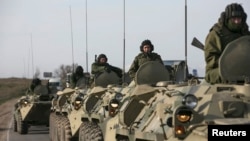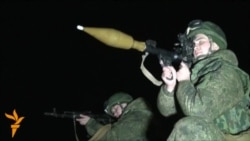Officials in Kyiv have warned that Russian military forces are massing on Ukraine's borders "in an offensive manner" and suggested they could be preparing for an invasion in the country's east.
What are the specific claims that Ukrainian officials have made about Russian military forces?
Andriy Parubiy, the secretary of Ukraine’s National Security and Defense Council, said on March 12 that Russian troops are massing along Ukraine’s borders for a possible invasion.
Parubiy said the troops are being deployed “in an offensive manner,” and that the forces include more than 80,000 soldiers, “up to 270 tanks, 180 armored vehicles, 380 artillery systems, 18 multiple-launch missile systems, 140 combat aircraft, 90 combat helicopters,” and 19 naval warships.
He added that the situation is “critical” not only in Crimea, “but along the entire northeastern frontier” -- with Russian troops in positions to seize eastern Ukrainian cities like Kharkiv and Donetsk, and to advance as far as Kyiv within two or three hours.
What is the evidence of such a buildup?
Photographs and videos, said to have been taken since March 10, have appeared on social media and in newspapers including Britain’s "Daily Mail."
Tim Ripley, a military analyst for Jane’s Defence Weekly, has reviewed the photographs and videos and concludes that it is too early to say whether Russia is, in fact, mobilizing for an invasion of eastern or northern Ukraine.
“They show lots of Russian vehicles. But they only show small groups of vehicles -- 10, 15, or 20 at a time -- so it is difficult to conclude that they are showing a huge mass of thousands of tanks just a two hour drive from Kyiv," Ripley said.
"They definitely show tanks and armored personnel carriers and other military equipment in places very close to the Ukrainian border. But to say they are an overwhelming mass concentration of forces for a major operation? You can’t make that jump -- certainly not yet -- on the basis of the evidence floating around on the Internet and in the news media.”
(WATCH: Russia Holds Military Exercises Near Ukrainian Border)
What about Kyiv's claim that 80,000 Russian troops are positioned "in an offensive manner" just across the border? What appears to be going on?
Ripley says the Russian forces described by authorities in Kyiv are not beyond the ordinary number of forces normally stationed in the region.
“You can show some movement and some positioning of Russian equipment near the Ukrainian border, but that 80,000, it is probably correct to say those are the troops that are normally based there anyway in what is called the southern and western Russian military district bordering Ukraine," Ripley said.
"So to say they are massing is perhaps hyperbole. I mean, the key indicator to say there is a massing of troops would be a call up of reservists -- of former conscripts -- to fill out the Russian units. Because a lot of these units based in the south [of Russia] are not kept at full strength in peacetime.”
What does the heightened activity of Russian forces near Ukraine’s border suggest?
The Kremlin describes the increased military activity near the Ukrainian border as a training exercise.
The Russian Defense Ministry’s website said on March 13 that about 8,500 troops are taking part in the drills, which include artillery and multiple-rocket launchers in its Southern Military District.
It says the exercise is aimed at improving the coordination between artillery, mechanized and tank units, paratroopers, and marines. The Defense Ministry did not say how long the exercise would last.
Until the Kremlin begins to call up reservists to fill out Russian forces -- or until a large number of conscripted troops are sent from other parts of Russia to the Ukrainian border region -- military experts like Ripley see Russian military posturing as a kind of psychological warfare campaign against Ukraine.
“The indicators suggest something is going on with movement of stuff. This is great psychological warfare against Ukraine, and a great act of intimidation to try and deter the Ukrainians from carrying out any military engagement against the occupation force in Crimea," Ripley said.
"You know, you hold a sort of hammer against the rear of the Ukrainian forces and you’ve got the Russian forces on the border making noises and driving around in public creating lots of impressions. The Ukrainians must be thinking, ‘Well, if we go south to take on the Russians in Crimea, all those Russians will come in behind us.’ It’s a great psychological warfare exercise.”
Would Russia be violating any international treaty obligations by massing the kind of forces described by Ukrainian officials?
Even by the standards of the Conventional Armed Forces in Europe Treaty (CFE), signed Warsaw Pact and NATO states in 1990, Russia would not be violating its international obligations by massing together the kind of force levels described by Ukrainian officials.
Under post-Soviet negotiations to update the CFE during the 1990s, limitations on the amount of military equipment that could be deployed in so called “flank zones” like Russia’s border region with Ukraine were eased.
Some parts of Rostov Oblast -- where the Southern Military District is headquartered -- were removed completely from flank zone limitations.
Meanwhile, the renegotiated agreement said Russian active units in the flank zone could hold no more than 700 tanks, 580 armored combat vehicles, and 1,280 artillery pieces.
The equipment numbers described by Kyiv do not appear to exceed the CFE’s flank zone limitations.
Moreover, Russia suspended its implementation of the CFE treaty in December 2007 -- essentially withdrawing from the treaty -- less than a year before Russia’s short war against Georgia in August, 2008.
The United States announced in 2011 that it also was suspending its reporting to Russia under the CFE treaty.
That essentially leaves Russia with the right under international law to position and deploy whatever forces it likes within its own territory.
What are the specific claims that Ukrainian officials have made about Russian military forces?
Andriy Parubiy, the secretary of Ukraine’s National Security and Defense Council, said on March 12 that Russian troops are massing along Ukraine’s borders for a possible invasion.
Parubiy said the troops are being deployed “in an offensive manner,” and that the forces include more than 80,000 soldiers, “up to 270 tanks, 180 armored vehicles, 380 artillery systems, 18 multiple-launch missile systems, 140 combat aircraft, 90 combat helicopters,” and 19 naval warships.
He added that the situation is “critical” not only in Crimea, “but along the entire northeastern frontier” -- with Russian troops in positions to seize eastern Ukrainian cities like Kharkiv and Donetsk, and to advance as far as Kyiv within two or three hours.
What is the evidence of such a buildup?
Photographs and videos, said to have been taken since March 10, have appeared on social media and in newspapers including Britain’s "Daily Mail."
Tim Ripley, a military analyst for Jane’s Defence Weekly, has reviewed the photographs and videos and concludes that it is too early to say whether Russia is, in fact, mobilizing for an invasion of eastern or northern Ukraine.
“They show lots of Russian vehicles. But they only show small groups of vehicles -- 10, 15, or 20 at a time -- so it is difficult to conclude that they are showing a huge mass of thousands of tanks just a two hour drive from Kyiv," Ripley said.
"They definitely show tanks and armored personnel carriers and other military equipment in places very close to the Ukrainian border. But to say they are an overwhelming mass concentration of forces for a major operation? You can’t make that jump -- certainly not yet -- on the basis of the evidence floating around on the Internet and in the news media.”
(WATCH: Russia Holds Military Exercises Near Ukrainian Border)
What about Kyiv's claim that 80,000 Russian troops are positioned "in an offensive manner" just across the border? What appears to be going on?
Ripley says the Russian forces described by authorities in Kyiv are not beyond the ordinary number of forces normally stationed in the region.
“You can show some movement and some positioning of Russian equipment near the Ukrainian border, but that 80,000, it is probably correct to say those are the troops that are normally based there anyway in what is called the southern and western Russian military district bordering Ukraine," Ripley said.
"So to say they are massing is perhaps hyperbole. I mean, the key indicator to say there is a massing of troops would be a call up of reservists -- of former conscripts -- to fill out the Russian units. Because a lot of these units based in the south [of Russia] are not kept at full strength in peacetime.”
What does the heightened activity of Russian forces near Ukraine’s border suggest?
The Kremlin describes the increased military activity near the Ukrainian border as a training exercise.
The Russian Defense Ministry’s website said on March 13 that about 8,500 troops are taking part in the drills, which include artillery and multiple-rocket launchers in its Southern Military District.
It says the exercise is aimed at improving the coordination between artillery, mechanized and tank units, paratroopers, and marines. The Defense Ministry did not say how long the exercise would last.
Until the Kremlin begins to call up reservists to fill out Russian forces -- or until a large number of conscripted troops are sent from other parts of Russia to the Ukrainian border region -- military experts like Ripley see Russian military posturing as a kind of psychological warfare campaign against Ukraine.
“The indicators suggest something is going on with movement of stuff. This is great psychological warfare against Ukraine, and a great act of intimidation to try and deter the Ukrainians from carrying out any military engagement against the occupation force in Crimea," Ripley said.
"You know, you hold a sort of hammer against the rear of the Ukrainian forces and you’ve got the Russian forces on the border making noises and driving around in public creating lots of impressions. The Ukrainians must be thinking, ‘Well, if we go south to take on the Russians in Crimea, all those Russians will come in behind us.’ It’s a great psychological warfare exercise.”
Would Russia be violating any international treaty obligations by massing the kind of forces described by Ukrainian officials?
Even by the standards of the Conventional Armed Forces in Europe Treaty (CFE), signed Warsaw Pact and NATO states in 1990, Russia would not be violating its international obligations by massing together the kind of force levels described by Ukrainian officials.
Under post-Soviet negotiations to update the CFE during the 1990s, limitations on the amount of military equipment that could be deployed in so called “flank zones” like Russia’s border region with Ukraine were eased.
Some parts of Rostov Oblast -- where the Southern Military District is headquartered -- were removed completely from flank zone limitations.
Meanwhile, the renegotiated agreement said Russian active units in the flank zone could hold no more than 700 tanks, 580 armored combat vehicles, and 1,280 artillery pieces.
The equipment numbers described by Kyiv do not appear to exceed the CFE’s flank zone limitations.
Moreover, Russia suspended its implementation of the CFE treaty in December 2007 -- essentially withdrawing from the treaty -- less than a year before Russia’s short war against Georgia in August, 2008.
The United States announced in 2011 that it also was suspending its reporting to Russia under the CFE treaty.
That essentially leaves Russia with the right under international law to position and deploy whatever forces it likes within its own territory.













